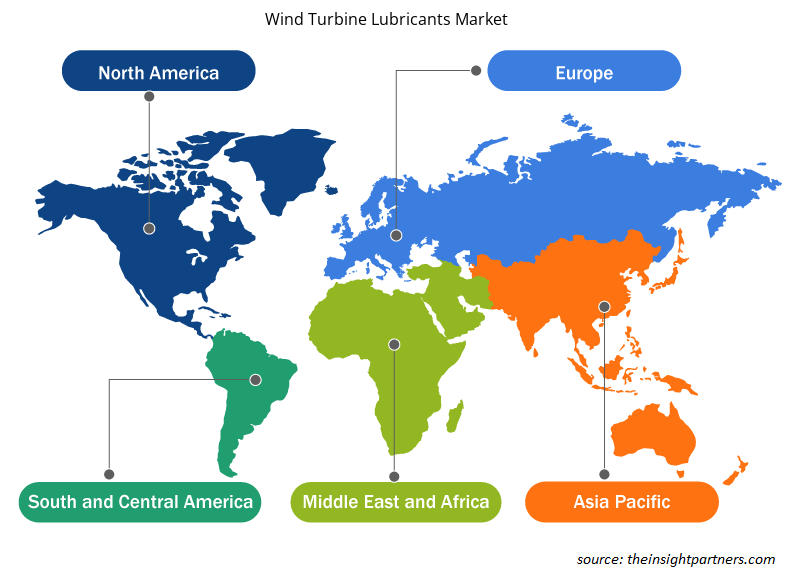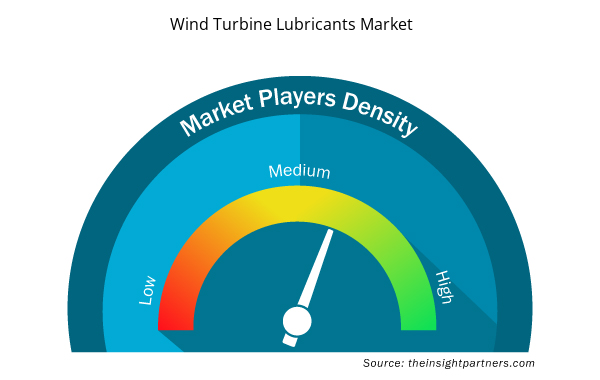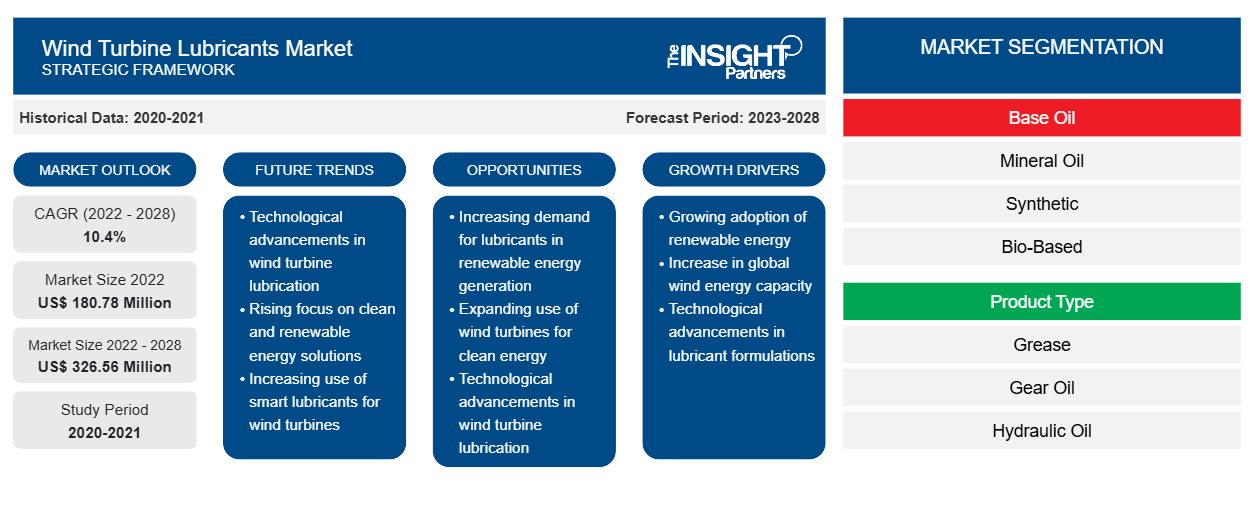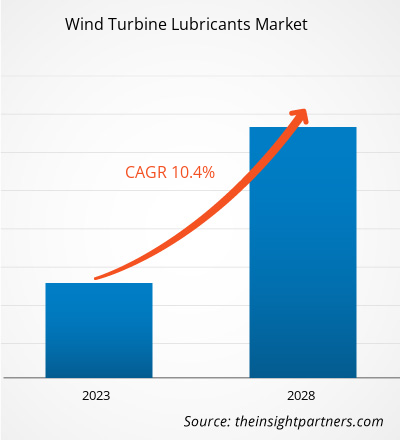[Rapporto di ricerca] Si prevede che il mercato dei lubrificanti per turbine eoliche crescerà da 180,78 milioni di dollari nel 2022 a 326,56 milioni di dollari entro il 2028; si stima che registrerà un CAGR del 10,4% dal 2022 al 2028.
I lubrificanti per turbine eoliche svolgono un ruolo importante nel funzionamento, nella manutenzione e nell'affidabilità delle attrezzature nei parchi eolici. Le turbine eoliche hanno vari punti di lubrificazione come riduttore, riduttore aperto, riduttore di passo, cuscinetto di passo, cuscinetto di imbardata, sistemi idraulici e cuscinetti del generatore. I diversi lubrificanti utilizzati nelle turbine eoliche sono oli per ingranaggi, oli idraulici e grassi. L'olio per ingranaggi è utilizzato per la lubrificazione dei riduttori. Nelle turbine eoliche, il grasso è utilizzato sul cuscinetto dell'albero del rotore principale, sul cuscinetto di imbardata, sugli ingranaggi di trasmissione del passo, sul cuscinetto delle pale e sul cuscinetto del generatore.
La quota di mercato globale dei lubrificanti per turbine eoliche per l'Asia Pacifico è stata la più grande nel 2022. Il mercato dei lubrificanti per turbine eoliche nell'Asia Pacifico è segmentato in Australia, Cina, India, Giappone, Corea del Sud e resto dell'Asia Pacifico. La Cina è un importante contributore alla crescita del mercato in questa regione. Il paese è stato il produttore di energia rinnovabile più grande e in più rapida crescita al mondo per oltre un decennio. Inoltre, ha il più grande mercato di energia eolica al mondo. La Cina è rimasta il più grande mercato al mondo per le nuove aggiunte onshore nel 2020, guidata dal taglio della tariffa feed-in (FiT). Anche l'India ha registrato una notevole crescita del settore dell'energia eolica grazie a varie politiche e normative favorevoli adottate dai governi nazionali e statali. Inoltre, paesi come Taiwan, Corea del Sud, Vietnam e Filippine stanno anche adottando varie iniziative per aumentare le loro capacità eoliche installate, aggiungendosi alla domanda di lubrificanti per turbine eoliche della regione.
Personalizza questo report in base alle tue esigenze
Riceverai la personalizzazione gratuita di qualsiasi report, comprese parti di questo report, o analisi a livello nazionale, pacchetto dati Excel, oltre a usufruire di grandi offerte e sconti per start-up e università
- Scopri le principali tendenze di mercato in questo rapporto.Questo campione GRATUITO includerà analisi di dati che spaziano dalle tendenze di mercato alle stime e alle previsioni.
Impatto della pandemia di COVID-19 sul mercato dei lubrificanti per turbine eoliche
Il sostegno governativo alle energie rinnovabili e l'aumento delle installazioni di turbine eoliche hanno contribuito in modo significativo alla crescita del mercato dei lubrificanti per turbine eoliche. Tuttavia, nel 2020, vari settori hanno dovuto rallentare le proprie attività a causa delle interruzioni nella catena del valore causate dalle restrizioni sui confini nazionali e internazionali. Ciò ha portato alla chiusura degli impianti di produzione, che ha avuto un impatto negativo sulla crescita del mercato dei lubrificanti per turbine eoliche all'inizio del 2020. Il calo delle installazioni eoliche all'inizio del 2020 ha ostacolato la domanda di lubrificanti per turbine eoliche.
Tuttavia, il settore dell'energia eolica si è ripreso con vigore nella seconda metà dell'anno, quando i mercati eolici maturi ed emergenti hanno iniziato a superare gli impatti della pandemia. Inoltre, il mercato globale ha iniziato a riprendersi dalle perdite subite in precedenza durante la pandemia, quando i governi di diversi paesi hanno annunciato allentamenti nelle restrizioni sociali. Inoltre, i crescenti tassi di vaccinazione hanno creato ambienti favorevoli al progresso industriale. Secondo il Global Wind Energy Council, l'industria eolica globale ha assistito a una crescita record anno su anno (YoY) del 53% nel 2020. L' industria ha installato oltre 93 GW di energia eolica durante il picco della pandemia di COVID-19, nonostante le interruzioni nella catena di fornitura globale e nella costruzione del progetto . Un aumento della capacità installata eolica ha comportato una maggiore domanda di lubrificanti per turbine eoliche, poiché i lubrificanti vengono utilizzati per lubrificare diverse parti delle turbine eoliche.
Approfondimenti di mercato
L'aumento della capacità eolica installata rafforza la domanda di lubrificanti per turbine eoliche
L'energia eolica aiuta a ridurre la dipendenza dai combustibili fossili, il che si traduce in un crescente interesse per questa risorsa rinnovabile in diversi paesi. Secondo il "Global Wind Report 2021" pubblicato dal Global Wind Energy Council, nel 2020, le nuove installazioni di energia eolica hanno superato i 90 GW, ovvero il 53% in più rispetto alla capacità aggiunta nel 2019. Ciò ha portato a una capacità installata totale di 743 GW nel mondo, registrando un aumento del 14% rispetto al 2019. Nel 2020, le nuove installazioni nei parchi eolici onshore hanno raggiunto 86,9 GW, mentre i parchi eolici offshore hanno raggiunto 6,1 GW, rendendo il 2020 rispettivamente l'anno più alto e il secondo più alto nella storia per le nuove installazioni eoliche onshore e offshore. Varie parti della turbina eolica devono essere lubrificate utilizzando grassi, oli per ingranaggi, oli idraulici e altri lubrificanti. Pertanto, la crescente capacità eolica installata a livello globale sta guidando la crescita del mercato dei lubrificanti per turbine eoliche.
Approfondimenti sugli oli base
In base all'olio base, il mercato globale dei lubrificanti per turbine eoliche è segmentato in olio minerale, sintetico e di origine biologica. Il segmento sintetico ha detenuto la quota di mercato più grande dei lubrificanti per turbine eoliche nel 2022. I lubrificanti sintetici sono realizzati con componenti di olio che sono stati prodotti sinteticamente attraverso la reazione di alcuni composti chimici ben definiti, che sono spesso a base di petrolio piuttosto che raffinati da greggi petroliferi esistenti o oli vegetali. I lubrificanti sintetici sono i lubrificanti più comunemente utilizzati nel settore delle turbine eoliche poiché gli oli sintetici hanno un punto di scorrimento inferiore, che consente al cambio di funzionare in modo efficiente a temperature più basse.
I principali attori che operano nel mercato globale dei lubrificanti per turbine eoliche includono TotalEnergies, Exxon Mobil Corporation, FUCHS, BP plc, Klüber Lubrication, Shell, Phillips 66 Company, Chevron, Afton Chemical, AMSOIL INC. e The Lubrizol Corporation. Gli attori del mercato globale si concentrano sulla fornitura di prodotti di alta qualità per soddisfare la domanda dei clienti. Per questo, investono in modo significativo in attività di ricerca e sviluppo.
Segnala i riflettori
- Tendenze industriali progressive nel mercato dei lubrificanti per turbine eoliche per aiutare gli operatori a sviluppare strategie efficaci a lungo termine
- Strategie di crescita aziendale adottate dai mercati sviluppati e in via di sviluppo
- Analisi quantitativa del mercato dei lubrificanti per turbine eoliche dal 2020 al 2028
- Stima della domanda globale di lubrificanti per turbine eoliche
- Analisi delle cinque forze di Porter per illustrare l'efficacia degli acquirenti e dei fornitori che operano nel settore
- Sviluppi recenti per comprendere lo scenario competitivo del mercato
- Tendenze e prospettive di mercato, nonché fattori che guidano e frenano la crescita del mercato dei lubrificanti per turbine eoliche
- Assistenza nel processo decisionale evidenziando le strategie di mercato che sostengono l'interesse commerciale, portando alla crescita del mercato
- Le dimensioni del mercato dei lubrificanti per turbine eoliche in vari nodi
- Panoramica dettagliata e segmentazione del mercato, nonché dinamiche del settore dei lubrificanti per turbine eoliche
- Le dimensioni del mercato dei lubrificanti per turbine eoliche in varie regioni con promettenti opportunità di crescita
Approfondimenti regionali sul mercato dei lubrificanti per turbine eoliche
Le tendenze regionali e i fattori che influenzano il mercato dei lubrificanti per turbine eoliche durante il periodo di previsione sono stati ampiamente spiegati dagli analisti di Insight Partners. Questa sezione discute anche i segmenti e la geografia del mercato dei lubrificanti per turbine eoliche in Nord America, Europa, Asia Pacifico, Medio Oriente e Africa e America meridionale e centrale.

- Ottieni i dati specifici regionali per il mercato dei lubrificanti per turbine eoliche
Ambito del rapporto di mercato sui lubrificanti per turbine eoliche
| Attributo del report | Dettagli |
|---|---|
| Dimensioni del mercato nel 2022 | 180,78 milioni di dollari USA |
| Dimensioni del mercato entro il 2028 | 326,56 milioni di dollari USA |
| CAGR globale (2022 - 2028) | 10,4% |
| Dati storici | 2020-2021 |
| Periodo di previsione | 2023-2028 |
| Segmenti coperti | Per olio base
|
| Regioni e Paesi coperti | America del Nord
|
| Leader di mercato e profili aziendali chiave |
|
Densità degli attori del mercato dei lubrificanti per turbine eoliche: comprendere il suo impatto sulle dinamiche aziendali
Il mercato dei lubrificanti per turbine eoliche sta crescendo rapidamente, spinto dalla crescente domanda degli utenti finali dovuta a fattori quali l'evoluzione delle preferenze dei consumatori, i progressi tecnologici e una maggiore consapevolezza dei vantaggi del prodotto. Con l'aumento della domanda, le aziende stanno ampliando le loro offerte, innovando per soddisfare le esigenze dei consumatori e capitalizzando sulle tendenze emergenti, il che alimenta ulteriormente la crescita del mercato.
La densità degli operatori di mercato si riferisce alla distribuzione di aziende o società che operano in un particolare mercato o settore. Indica quanti concorrenti (operatori di mercato) sono presenti in un dato spazio di mercato in relazione alle sue dimensioni o al valore di mercato totale.
Le principali aziende che operano nel mercato dei lubrificanti per turbine eoliche sono:
- Totale Energie SE
- Società anonima BP
- Gallone
- ExxonMobil Corporation
- FUCHS Petrolub SE
Disclaimer : le aziende elencate sopra non sono classificate secondo un ordine particolare.

- Ottieni una panoramica dei principali attori del mercato dei lubrificanti per turbine eoliche
Mercato dei lubrificanti per turbine eoliche
In base all'olio base, il mercato dei lubrificanti per turbine eoliche è segmentato in olio minerale, sintetico e di origine biologica. Il mercato globale dei lubrificanti per turbine eoliche è segmentato in base al tipo di prodotto in grasso, olio per ingranaggi, olio idraulico e altri.
Profili aziendali
- Totale Energie SE
- Società anonima BP
- Gallone
- ExxonMobil Corporation
- FUCHS Petrolub SE
- Klüber Lubrication GmbH & Co.
- Azienda Phillips 66
- Società per azioni Shell
- La società Lubrizol
- Prodotti chimici Afton
- SOCIETÀ AMMINISTRATIVA AMSOIL INC.
- Analisi storica (2 anni), anno base, previsione (7 anni) con CAGR
- Analisi PEST e SWOT
- Valore/volume delle dimensioni del mercato - Globale, regionale, nazionale
- Industria e panorama competitivo
- Set di dati Excel



Report Coverage
Revenue forecast, Company Analysis, Industry landscape, Growth factors, and Trends

Segment Covered
This text is related
to segments covered.

Regional Scope
North America, Europe, Asia Pacific, Middle East & Africa, South & Central America

Country Scope
This text is related
to country scope.
Domande frequenti
Asia Pacific is estimated to register the fastest CAGR in the global wind turbine lubricants market over the forecast period. The increasing installed wind capacity in China, Japan, India, and Australia, among others, are driving the demand for wind turbine lubricants in Asia Pacific.
The gear oil segment held the largest share of the global wind turbine lubricants market in 2022. Gear oil is one of the most widely used wind turbine lubricants. It is used in lubricating gearboxes. Enclosed gearboxes are an important component in the nacelles of many wind turbines.
The projected growth of the market is attributed to the increasing installed wind capacity and government initiatives for the development of the wind energy sector.
The key players operating in the global wind turbine lubricants market include TotalEnergies, Exxon Mobil Corporation, FUCHS, BP p.l.c., Klüber Lubrication, Shell, Phillips 66 Company, Chevron, Afton Chemical, AMSOIL INC., and The Lubrizol Corporation.
In 2022, Asia Pacific held the largest share of the global wind turbine lubricants market. China is a major contributor to the market growth in Asia Pacific. The country has the world’s largest wind energy market. China remained the world’s largest market for new onshore additions in 2020, driven by the feed-in tariff cut-off. India also records the remarkable growth of the wind power industry due to policies and regulations adopted by the union and state governments.
The synthetic segment held the largest share in the global wind turbine lubricants market in 2022. Synthetic lubricants are made of oil components that have been manufactured synthetically by reaction of a few well-defined chemical compounds. They are the most commonly used lubricants in the wind turbine industry as synthetic oils have a lower pour point, which enables the gearbox to operate efficiently at lower temperature.
Trends and growth analysis reports related to Chemicals and Materials : READ MORE..
The List of Companies - Wind Turbine Lubricants Market
- TotalEnergies SE
- BP p.l.c.
- Chevron
- Exxon Mobil Corporation
- FUCHS Petrolub SE
- Klüber Lubrication GmbH & Co.
- Phillips 66 Company
- Shell Plc
- The Lubrizol Corporation
- Afton Chemical
- AMSOIL INC.
The Insight Partners performs research in 4 major stages: Data Collection & Secondary Research, Primary Research, Data Analysis and Data Triangulation & Final Review.
- Data Collection and Secondary Research:
As a market research and consulting firm operating from a decade, we have published and advised several client across the globe. First step for any study will start with an assessment of currently available data and insights from existing reports. Further, historical and current market information is collected from Investor Presentations, Annual Reports, SEC Filings, etc., and other information related to company’s performance and market positioning are gathered from Paid Databases (Factiva, Hoovers, and Reuters) and various other publications available in public domain.
Several associations trade associates, technical forums, institutes, societies and organization are accessed to gain technical as well as market related insights through their publications such as research papers, blogs and press releases related to the studies are referred to get cues about the market. Further, white papers, journals, magazines, and other news articles published in last 3 years are scrutinized and analyzed to understand the current market trends.
- Primary Research:
The primarily interview analysis comprise of data obtained from industry participants interview and answers to survey questions gathered by in-house primary team.
For primary research, interviews are conducted with industry experts/CEOs/Marketing Managers/VPs/Subject Matter Experts from both demand and supply side to get a 360-degree view of the market. The primary team conducts several interviews based on the complexity of the markets to understand the various market trends and dynamics which makes research more credible and precise.
A typical research interview fulfils the following functions:
- Provides first-hand information on the market size, market trends, growth trends, competitive landscape, and outlook
- Validates and strengthens in-house secondary research findings
- Develops the analysis team’s expertise and market understanding
Primary research involves email interactions and telephone interviews for each market, category, segment, and sub-segment across geographies. The participants who typically take part in such a process include, but are not limited to:
- Industry participants: VPs, business development managers, market intelligence managers and national sales managers
- Outside experts: Valuation experts, research analysts and key opinion leaders specializing in the electronics and semiconductor industry.
Below is the breakup of our primary respondents by company, designation, and region:

Once we receive the confirmation from primary research sources or primary respondents, we finalize the base year market estimation and forecast the data as per the macroeconomic and microeconomic factors assessed during data collection.
- Data Analysis:
Once data is validated through both secondary as well as primary respondents, we finalize the market estimations by hypothesis formulation and factor analysis at regional and country level.
- Macro-Economic Factor Analysis:
We analyse macroeconomic indicators such the gross domestic product (GDP), increase in the demand for goods and services across industries, technological advancement, regional economic growth, governmental policies, the influence of COVID-19, PEST analysis, and other aspects. This analysis aids in setting benchmarks for various nations/regions and approximating market splits. Additionally, the general trend of the aforementioned components aid in determining the market's development possibilities.
- Country Level Data:
Various factors that are especially aligned to the country are taken into account to determine the market size for a certain area and country, including the presence of vendors, such as headquarters and offices, the country's GDP, demand patterns, and industry growth. To comprehend the market dynamics for the nation, a number of growth variables, inhibitors, application areas, and current market trends are researched. The aforementioned elements aid in determining the country's overall market's growth potential.
- Company Profile:
The “Table of Contents” is formulated by listing and analyzing more than 25 - 30 companies operating in the market ecosystem across geographies. However, we profile only 10 companies as a standard practice in our syndicate reports. These 10 companies comprise leading, emerging, and regional players. Nonetheless, our analysis is not restricted to the 10 listed companies, we also analyze other companies present in the market to develop a holistic view and understand the prevailing trends. The “Company Profiles” section in the report covers key facts, business description, products & services, financial information, SWOT analysis, and key developments. The financial information presented is extracted from the annual reports and official documents of the publicly listed companies. Upon collecting the information for the sections of respective companies, we verify them via various primary sources and then compile the data in respective company profiles. The company level information helps us in deriving the base number as well as in forecasting the market size.
- Developing Base Number:
Aggregation of sales statistics (2020-2022) and macro-economic factor, and other secondary and primary research insights are utilized to arrive at base number and related market shares for 2022. The data gaps are identified in this step and relevant market data is analyzed, collected from paid primary interviews or databases. On finalizing the base year market size, forecasts are developed on the basis of macro-economic, industry and market growth factors and company level analysis.
- Data Triangulation and Final Review:
The market findings and base year market size calculations are validated from supply as well as demand side. Demand side validations are based on macro-economic factor analysis and benchmarks for respective regions and countries. In case of supply side validations, revenues of major companies are estimated (in case not available) based on industry benchmark, approximate number of employees, product portfolio, and primary interviews revenues are gathered. Further revenue from target product/service segment is assessed to avoid overshooting of market statistics. In case of heavy deviations between supply and demand side values, all thes steps are repeated to achieve synchronization.
We follow an iterative model, wherein we share our research findings with Subject Matter Experts (SME’s) and Key Opinion Leaders (KOLs) until consensus view of the market is not formulated – this model negates any drastic deviation in the opinions of experts. Only validated and universally acceptable research findings are quoted in our reports.
We have important check points that we use to validate our research findings – which we call – data triangulation, where we validate the information, we generate from secondary sources with primary interviews and then we re-validate with our internal data bases and Subject matter experts. This comprehensive model enables us to deliver high quality, reliable data in shortest possible time.


 Ottieni un campione gratuito per questo repot
Ottieni un campione gratuito per questo repot